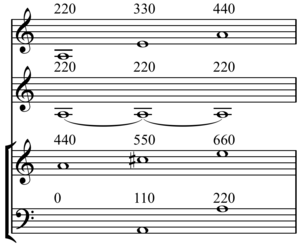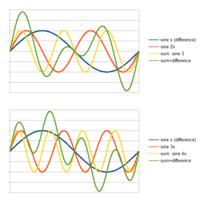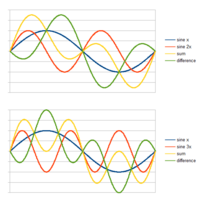87:
1022:
122:
63:
99:
51:
75:
24:
134:
37:
17:
1309:
678:
below the first pitch when the second is the fifth, 3:2, two octaves below when the second is the major third, 5:4). This effect is useful especially in the lowest ranks of the pipe organ where cost or space could prohibit having a rank of such low pitch. For example, a 32' pipe would be costly and
679:
take up as much as 16' of vertical space (if capped) or more commonly 17-32' (if open-ended) for each pipe. Using a resultant tone for such low pitches reduces the cost and space factor, but does not sound as full as a true 32' pipe. The effect can be enhanced by using further
20:
Combination tones: Unison, just perfect fifth, and octave are played in top row while A220 is sustained in second row, producing third row sum tones and fourth row difference tones. Frequencies are marked in Hz. Midi example contains all four voices for illustration only.
445:, generating relatively faint components with frequencies equal to the sums and differences of whole multiples of the original frequencies. Any components which are heard are usually lower, with the most commonly heard frequency being just the difference tone,
88:
185:
whose frequencies are the difference between the frequencies of the real tones. "Combination tones are heard when two pure tones (i.e., tones produced by simple harmonic sound waves having no overtones), differing in frequency by about 50 cycles per second
690:
This effect is most often used in the lowest octave of the organ only. It can vary from highly effective to disappointing depending on several factors, primarily the skill of the organ voicer, and the acoustics of the room the instrument is installed in.
64:
76:
100:
52:
25:
628:
to each ear separately, listeners may still hear a difference tone. Since the peculiar non-linear physics of the ear doesn't come into play in this case, it is thought that this must be a separate, neural phenomenon. Compare
615:
424:
483:
620:
For a time it was thought that the inner ear was solely responsible whenever a sum or difference tone was heard. However, experiments show evidence that even when using
162:
phenomenon of an additional tone or tones that are artificially perceived when two real tones are sounded at the same time. Their discovery is credited to the violinist
353:
309:
265:
238:
192:
Combination tones can also be produced electronically by combining two signals in a circuit that has nonlinear distortion, such as an amplifier subject to
865:
A Comprehensive
Dictionary of Organ Stops: English and foreign, ancient and modern: practical, theoretical, historical, aesthetic, etymological, phonetic
114:
Sum and difference of frequencies (left) and sum and difference of two pairs of sine waves (right) with frequencies of 1 and 2 (top) and 1 and 3 (bottom)
893:, Practice book with combination tones for two flutes or two recorders – Explanation and examples, Edition Floeno 2020, ISMN 979-0-9000114-2-8
491:
928:
Uses combination tones for pitch recognition. If certain intervals are played in double-stop, the program can display its
Tartini-tone.
921:
913:
485:, though this may be a consequence of the other phenomena. Although much less common, the following frequencies may also be heard:
1231:
429:
The specific phenomenon that
Tartini discovered was physical. Sum and difference tones are thought to be caused sometimes by the
694:
It is possible to produce a melody with resultant tones from multiple harmonics played by two or more instruments. There is
666:, this is done by having two pipes, one pipe of the note being played, and another harmonically related, typically at its
958:
883:
814:
748:
908:
886:, Massachusetts Institute of Technology, Research Laboratory of Electronics, Technical Report 484, October 1, 1971.
311:
etc. Since a fifth corresponds to a frequency ratio of 2:3, the higher tone and its harmonics would then be
193:
121:
903:
358:
1070:
438:
848:
1191:
1246:
1126:
983:
951:
884:"Percepetion of Musical Intervals: Evidence for the Central Origin of the Pitch of Complex Tones"
684:
640:
448:
1065:
975:
314:
270:
1206:
1104:
1008:
785:
241:
863:
133:
918:
8:
1226:
1136:
781:
659:
is "produced when any two loud and sustained musical sounds are heard at the same time."
217:
247:
1333:
1312:
1158:
1148:
1109:
944:
442:
426:
etc. The missing fundamental is heard because so many of these components refer to it.
223:
1021:
208:
One way a difference tone can be heard is when two tones with fairly complete sets of
1282:
1114:
810:
764:
744:
1338:
1292:
1211:
1175:
1094:
1003:
717:
163:
707:
36:
1287:
1241:
1082:
1040:
925:
712:
644:
16:
1236:
1221:
1168:
830:
826:
630:
197:
159:
695:
1327:
1201:
1163:
1131:
1086:
1048:
998:
993:
931:
736:
667:
430:
45:
41:
1196:
636:
355:
etc. When both tones are sounded, there are components with frequencies of
1216:
1028:
671:
1277:
1267:
1053:
680:
663:
621:
610:{\displaystyle 2f_{1}-f_{2},3f_{1}-2f_{2},\ldots ,f_{1}-k(f_{2}-f_{1})}
213:
1058:
988:
967:
625:
434:
267:
would be the frequency of the lower tone, and its harmonics would be
209:
178:
670:, being sounded at the same time. The result is a pitch at a common
1153:
1121:
1099:
675:
1272:
187:
936:
1262:
181:
are found by adding the frequencies of the real tones, and
441:
of the various frequencies which enter the ear. They are
861:
494:
451:
361:
317:
273:
250:
226:
837:, Max V. Mathews and John R. Pierce, eds. MIT Press.
774:
643:on the basis of combination tones, as well as the
609:
477:
418:
347:
303:
259:
232:
189:or more, sound together at sufficient intensity."
1325:
952:
882:Adrianus J. M. Houtsma, Julius L. Goldstein,
835:Current Directions in Computer Music Research
216:. This can be explained as an example of the
959:
945:
932:http://www.organstops.org/r/Resultant.html
833:(1989). "The Bohlen–Pierce Scale", p.167.
173:There are two types of combination tones:
849:Grove's Dictionary of Music and Musicians
35:
15:
868:(2nd ed.). G. Schirmer. p. 1.
743:, p.83. Courier, Dover Books on Music.
1326:
759:
757:
940:
127:sum and difference of the frequencies
846:Maitland, J. A. Fuller; ed. (1909).
139:sum and difference of the sine waves
904:Titchener Difference Tones Training
754:
40:Difference tones (bottom) between "
13:
876:
639:proposed what is now known as the
419:{\displaystyle 2f,3f,4f,6f,8f,9f,}
14:
1350:
909:Difference tones on the harmonica
897:
650:
1308:
1307:
1020:
696:an example with seven saxophones
132:
120:
687:of the desired resultant tone.
914:Pitch Perception Lecture Notes
862:James Ingall Wedgwood (1907).
855:
852:, Volume 4, p.76. Macmillan. .
840:
820:
799:
730:
604:
578:
203:
1:
966:
809:, p.81-2. The Boydell Press.
723:
166:and so they are also called
7:
741:Horns, Strings, and Harmony
701:
674:of the pitches played (one
478:{\displaystyle f_{2}-f_{1}}
10:
1355:
771:. Accessed September 2015.
439:intermodulation distortion
1303:
1255:
1184:
1081:
1039:
1015:
974:
919:Tartini computer program.
348:{\displaystyle 3f,6f,9f,}
304:{\displaystyle 4f,6f,8f,}
984:Architectural acoustics
805:Beament, James (2001).
1071:Fletcher–Munson curves
1066:Equal-loudness contour
976:Acoustical engineering
611:
479:
420:
349:
305:
261:
234:
108:
33:
1207:Hermann von Helmholtz
1105:Fundamental frequency
1009:Sympathetic resonance
786:Enciclopedia Italiana
612:
480:
421:
350:
306:
262:
242:fundamental frequency
235:
39:
19:
708:Power chord#Analysis
492:
449:
359:
315:
271:
248:
224:
1227:Werner Meyer-Eppler
1137:Missing fundamental
782:"Tartini, Giuseppe"
641:Bohlen–Pierce scale
624:providing a single
218:missing fundamental
44:" in F (top) and a
1110:Frequency spectrum
924:2013-06-23 at the
607:
475:
416:
345:
301:
260:{\displaystyle 2f}
257:
230:
109:
34:
1321:
1320:
1283:Musical acoustics
1115:harmonic spectrum
807:How We Hear Music
737:Benade, Arthur H.
443:combined linearly
233:{\displaystyle f}
1346:
1311:
1310:
1212:Carleen Hutchins
1144:Combination tone
1031:
1024:
1004:String vibration
961:
954:
947:
938:
937:
870:
869:
859:
853:
844:
838:
824:
818:
803:
797:
796:
794:
792:
778:
772:
765:Combination Tone
761:
752:
734:
718:Beat (acoustics)
616:
614:
613:
608:
603:
602:
590:
589:
571:
570:
552:
551:
536:
535:
520:
519:
507:
506:
484:
482:
481:
476:
474:
473:
461:
460:
425:
423:
422:
417:
354:
352:
351:
346:
310:
308:
307:
302:
266:
264:
263:
258:
239:
237:
236:
231:
183:difference tones
164:Giuseppe Tartini
148:combination tone
136:
124:
107:
106:
105:
103:
95:
94:
93:
91:
90:difference tones
83:
82:
81:
79:
71:
70:
69:
67:
59:
58:
57:
55:
32:
31:
30:
28:
1354:
1353:
1349:
1348:
1347:
1345:
1344:
1343:
1324:
1323:
1322:
1317:
1299:
1251:
1242:D. Van Holliday
1180:
1149:Mersenne's laws
1083:Audio frequency
1077:
1041:Psychoacoustics
1035:
1034:
1027:
1013:
970:
965:
926:Wayback Machine
900:
889:Adrian Wehlte,
879:
877:Further reading
874:
873:
860:
856:
845:
841:
825:
821:
804:
800:
790:
788:
780:
779:
775:
762:
755:
735:
731:
726:
713:Ring modulation
704:
685:harmonic series
653:
645:833 cents scale
598:
594:
585:
581:
566:
562:
547:
543:
531:
527:
515:
511:
502:
498:
493:
490:
489:
469:
465:
456:
452:
450:
447:
446:
437:. This causes
360:
357:
356:
316:
313:
312:
272:
269:
268:
249:
246:
245:
240:is the missing
225:
222:
221:
220:phenomenon. If
206:
144:
143:
142:
141:
140:
137:
129:
128:
125:
116:
115:
101:
98:
97:
89:
86:
85:
77:
74:
73:
65:
62:
61:
53:
50:
49:
26:
23:
22:
12:
11:
5:
1352:
1342:
1341:
1336:
1319:
1318:
1316:
1315:
1304:
1301:
1300:
1298:
1297:
1296:
1295:
1290:
1280:
1275:
1270:
1265:
1259:
1257:
1256:Related topics
1253:
1252:
1250:
1249:
1244:
1239:
1237:Joseph Sauveur
1234:
1229:
1224:
1222:Marin Mersenne
1219:
1214:
1209:
1204:
1199:
1194:
1188:
1186:
1182:
1181:
1179:
1178:
1173:
1172:
1171:
1161:
1156:
1151:
1146:
1141:
1140:
1139:
1134:
1129:
1119:
1118:
1117:
1107:
1102:
1097:
1091:
1089:
1079:
1078:
1076:
1075:
1074:
1073:
1063:
1062:
1061:
1056:
1045:
1043:
1037:
1036:
1033:
1032:
1025:
1017:
1016:
1014:
1012:
1011:
1006:
1001:
996:
991:
986:
980:
978:
972:
971:
964:
963:
956:
949:
941:
935:
934:
929:
916:
911:
906:
899:
898:External links
896:
895:
894:
887:
878:
875:
872:
871:
854:
839:
831:John R. Pierce
827:Max V. Mathews
819:
798:
773:
769:Britannica.com
753:
728:
727:
725:
722:
721:
720:
715:
710:
703:
700:
657:resultant tone
652:
651:Resultant tone
649:
631:binaural beats
618:
617:
606:
601:
597:
593:
588:
584:
580:
577:
574:
569:
565:
561:
558:
555:
550:
546:
542:
539:
534:
530:
526:
523:
518:
514:
510:
505:
501:
497:
472:
468:
464:
459:
455:
415:
412:
409:
406:
403:
400:
397:
394:
391:
388:
385:
382:
379:
376:
373:
370:
367:
364:
344:
341:
338:
335:
332:
329:
326:
323:
320:
300:
297:
294:
291:
288:
285:
282:
279:
276:
256:
253:
229:
205:
202:
198:ring modulator
160:psychoacoustic
138:
131:
130:
126:
119:
118:
117:
113:
112:
111:
110:
48:on C (middle)
9:
6:
4:
3:
2:
1351:
1340:
1337:
1335:
1332:
1331:
1329:
1314:
1306:
1305:
1302:
1294:
1291:
1289:
1286:
1285:
1284:
1281:
1279:
1276:
1274:
1271:
1269:
1266:
1264:
1261:
1260:
1258:
1254:
1248:
1245:
1243:
1240:
1238:
1235:
1233:
1232:Lord Rayleigh
1230:
1228:
1225:
1223:
1220:
1218:
1215:
1213:
1210:
1208:
1205:
1203:
1202:Ernst Chladni
1200:
1198:
1195:
1193:
1190:
1189:
1187:
1183:
1177:
1174:
1170:
1167:
1166:
1165:
1164:Standing wave
1162:
1160:
1157:
1155:
1152:
1150:
1147:
1145:
1142:
1138:
1135:
1133:
1132:Inharmonicity
1130:
1128:
1125:
1124:
1123:
1120:
1116:
1113:
1112:
1111:
1108:
1106:
1103:
1101:
1098:
1096:
1093:
1092:
1090:
1088:
1084:
1080:
1072:
1069:
1068:
1067:
1064:
1060:
1057:
1055:
1052:
1051:
1050:
1047:
1046:
1044:
1042:
1038:
1030:
1026:
1023:
1019:
1018:
1010:
1007:
1005:
1002:
1000:
999:Soundproofing
997:
995:
994:Reverberation
992:
990:
987:
985:
982:
981:
979:
977:
973:
969:
962:
957:
955:
950:
948:
943:
942:
939:
933:
930:
927:
923:
920:
917:
915:
912:
910:
907:
905:
902:
901:
892:
891:Trios for Two
888:
885:
881:
880:
867:
866:
858:
851:
850:
843:
836:
832:
828:
823:
816:
815:0-85115-813-7
812:
808:
802:
787:
783:
777:
770:
766:
760:
758:
750:
749:9780486173597
746:
742:
738:
733:
729:
719:
716:
714:
711:
709:
706:
705:
699:
697:
692:
688:
686:
682:
677:
673:
669:
665:
660:
658:
648:
646:
642:
638:
634:
632:
627:
623:
599:
595:
591:
586:
582:
575:
572:
567:
563:
559:
556:
553:
548:
544:
540:
537:
532:
528:
524:
521:
516:
512:
508:
503:
499:
495:
488:
487:
486:
470:
466:
462:
457:
453:
444:
440:
436:
432:
431:non-linearity
427:
413:
410:
407:
404:
401:
398:
395:
392:
389:
386:
383:
380:
377:
374:
371:
368:
365:
362:
342:
339:
336:
333:
330:
327:
324:
321:
318:
298:
295:
292:
289:
286:
283:
280:
277:
274:
254:
251:
243:
227:
219:
215:
211:
201:
199:
195:
190:
188:
184:
180:
176:
171:
169:
168:Tartini tones
165:
161:
157:
153:
150:(also called
149:
135:
123:
104:
92:
80:
68:
56:
47:
43:
42:Yankee Doodle
38:
29:
18:
1247:Thomas Young
1197:Jens Blauert
1185:Acousticians
1143:
890:
864:
857:
847:
842:
834:
822:
806:
801:
789:. Retrieved
776:
768:
740:
732:
693:
689:
661:
656:
654:
637:Heinz Bohlen
635:
619:
428:
207:
191:
182:
174:
172:
167:
155:
151:
147:
145:
1217:Franz Melde
1192:John Backus
1176:Subharmonic
1029:Spectrogram
672:subharmonic
664:pipe organs
204:Explanation
179:frequencies
158:tone) is a
1328:Categories
1278:Ultrasound
1268:Infrasound
1054:Bark scale
724:References
622:headphones
214:just fifth
156:subjective
1334:Acoustics
1159:Resonance
1059:Mel scale
989:Monochord
968:Acoustics
626:pure tone
592:−
573:−
557:…
538:−
509:−
463:−
435:inner ear
210:harmonics
175:sum tones
152:resultant
102:all three
1313:Category
1154:Overtone
1122:Harmonic
922:Archived
739:(2014).
702:See also
194:clipping
54:Play top
1339:Hearing
1100:Formant
791:1 April
683:in the
433:of the
244:, then
212:make a
1293:Violin
1127:Series
813:
747:
676:octave
177:whose
1288:Piano
1273:Sound
1087:pitch
1049:Pitch
681:ranks
668:fifth
196:or a
96:, or
66:drone
46:drone
1263:Echo
1169:Node
1095:Beat
1085:and
829:and
811:ISBN
793:2021
745:ISBN
78:both
27:Play
767:",
662:In
154:or
1330::
784:.
756:^
698:.
655:A
647:.
633:.
200:.
170:.
146:A
84:,
72:,
60:,
960:e
953:t
946:v
817:.
795:.
763:"
751:.
605:)
600:1
596:f
587:2
583:f
579:(
576:k
568:1
564:f
560:,
554:,
549:2
545:f
541:2
533:1
529:f
525:3
522:,
517:2
513:f
504:1
500:f
496:2
471:1
467:f
458:2
454:f
414:,
411:f
408:9
405:,
402:f
399:8
396:,
393:f
390:6
387:,
384:f
381:4
378:,
375:f
372:3
369:,
366:f
363:2
343:,
340:f
337:9
334:,
331:f
328:6
325:,
322:f
319:3
299:,
296:f
293:8
290:,
287:f
284:6
281:,
278:f
275:4
255:f
252:2
228:f
Text is available under the Creative Commons Attribution-ShareAlike License. Additional terms may apply.



